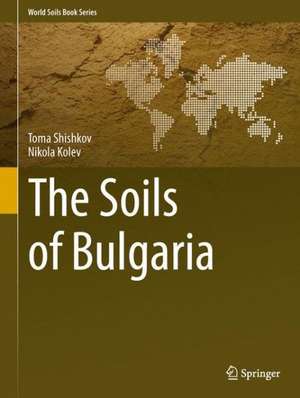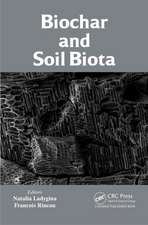The Soils of Bulgaria: World Soils Book Series
Autor Toma Shishkov, Nikola Koleven Limba Engleză Hardback – 19 mar 2014
| Toate formatele și edițiile | Preț | Express |
|---|---|---|
| Paperback (1) | 643.99 lei 43-57 zile | |
| SPRINGER NETHERLANDS – 3 sep 2016 | 643.99 lei 43-57 zile | |
| Hardback (1) | 579.73 lei 38-44 zile | |
| SPRINGER NETHERLANDS – 19 mar 2014 | 579.73 lei 38-44 zile |
Din seria World Soils Book Series
- 18%
 Preț: 962.81 lei
Preț: 962.81 lei - 18%
 Preț: 1231.01 lei
Preț: 1231.01 lei - 18%
 Preț: 974.98 lei
Preț: 974.98 lei - 18%
 Preț: 791.71 lei
Preț: 791.71 lei - 18%
 Preț: 914.20 lei
Preț: 914.20 lei - 18%
 Preț: 998.97 lei
Preț: 998.97 lei - 18%
 Preț: 978.12 lei
Preț: 978.12 lei - 15%
 Preț: 649.87 lei
Preț: 649.87 lei - 15%
 Preț: 646.62 lei
Preț: 646.62 lei - 18%
 Preț: 739.62 lei
Preț: 739.62 lei - 15%
 Preț: 649.87 lei
Preț: 649.87 lei - 18%
 Preț: 949.23 lei
Preț: 949.23 lei - 15%
 Preț: 642.65 lei
Preț: 642.65 lei - 20%
 Preț: 607.19 lei
Preț: 607.19 lei - 24%
 Preț: 762.77 lei
Preț: 762.77 lei - 24%
 Preț: 1076.16 lei
Preț: 1076.16 lei - 24%
 Preț: 771.02 lei
Preț: 771.02 lei - 20%
 Preț: 574.08 lei
Preț: 574.08 lei - 24%
 Preț: 921.13 lei
Preț: 921.13 lei - 20%
 Preț: 609.00 lei
Preț: 609.00 lei - 24%
 Preț: 751.00 lei
Preț: 751.00 lei - 24%
 Preț: 861.56 lei
Preț: 861.56 lei - 24%
 Preț: 966.56 lei
Preț: 966.56 lei - 24%
 Preț: 816.95 lei
Preț: 816.95 lei - 20%
 Preț: 579.73 lei
Preț: 579.73 lei - 24%
 Preț: 602.44 lei
Preț: 602.44 lei - 20%
 Preț: 591.82 lei
Preț: 591.82 lei - 24%
 Preț: 747.89 lei
Preț: 747.89 lei - 18%
 Preț: 907.11 lei
Preț: 907.11 lei - 20%
 Preț: 589.58 lei
Preț: 589.58 lei - 24%
 Preț: 640.77 lei
Preț: 640.77 lei - 24%
 Preț: 813.41 lei
Preț: 813.41 lei - 24%
 Preț: 886.56 lei
Preț: 886.56 lei
Preț: 579.73 lei
Preț vechi: 724.66 lei
-20% Nou
Puncte Express: 870
Preț estimativ în valută:
110.97€ • 120.57$ • 93.27£
110.97€ • 120.57$ • 93.27£
Carte tipărită la comandă
Livrare economică 16-22 aprilie
Preluare comenzi: 021 569.72.76
Specificații
ISBN-13: 9789400777835
ISBN-10: 9400777833
Pagini: 208
Ilustrații: XVI, 208 p. 170 illus., 86 illus. in color.
Dimensiuni: 210 x 279 x 20 mm
Greutate: 0.73 kg
Ediția:2014
Editura: SPRINGER NETHERLANDS
Colecția Springer
Seria World Soils Book Series
Locul publicării:Dordrecht, Netherlands
ISBN-10: 9400777833
Pagini: 208
Ilustrații: XVI, 208 p. 170 illus., 86 illus. in color.
Dimensiuni: 210 x 279 x 20 mm
Greutate: 0.73 kg
Ediția:2014
Editura: SPRINGER NETHERLANDS
Colecția Springer
Seria World Soils Book Series
Locul publicării:Dordrecht, Netherlands
Public țintă
ResearchCuprins
Contents.- Preface and acknowledgements.- Introduction .- Chapter 1. General facts of soils in Bulgaria.- Chapter 2. Chernozems.- Chapter 3. Grey-brown forest soils.- Chapter 4. Pseudopodzolic soils.- Chapter 5. Zheltozem soils.- Chapter 6. Smolnitza.- Chapter 7. Cinnamonic forest soils.- Chapter 8. Brown Forest Soils.- Chapter 9. Dark mountainous forest and mountainous meadow soils.- Chapter 10. Alluvial and deluvial soils.- Chapter 11. Hydromorphic soils with gleyic properties.- Chapter 12. Saline soils.- Chapter 13. Soils manifested slight development.- Chapter 14. Rendzinas (humus-calcareous) soils.- Chapter 15. Land use/cover in Bulgaria.- Chapter 16 Soils and humans.
Textul de pe ultima copertă
The Soils of Bulgaria offers a comprehensive analysis of the characteristics of soils and concepts on their magnitude. The purpose of the book is to introduce readers to the soil problematic and ecology in Bulgaria.
The volume is divided into 3 parts. The first includes historical facts on soil research in Bulgaria, as well as general conditions and factors of soil formation, while the second applies an original pedological approach. The book’s third part focuses on essential information concerning land use/cover in Bulgaria.
Each of the 13 chapters deals more specifically with fundamental chemical and physical soil properties, concepts of soil evolution, old and modern processes, geographic distribution, climatic conditions, topography, parent materials, plant associations, morphology, and the relationship with different classification systems.
The interactions between soil status and management are also highlighted. The use of the latest, statistically significant data ensures precise conclusions. The book also includes a large number of charts and new illustrations.
The Soils of Bulgaria is crucial reading material for anyone interested in soil management and agriculture in Easter Europe, from students to policy makers and is also of particular interest for researchers in the field.
The volume is divided into 3 parts. The first includes historical facts on soil research in Bulgaria, as well as general conditions and factors of soil formation, while the second applies an original pedological approach. The book’s third part focuses on essential information concerning land use/cover in Bulgaria.
Each of the 13 chapters deals more specifically with fundamental chemical and physical soil properties, concepts of soil evolution, old and modern processes, geographic distribution, climatic conditions, topography, parent materials, plant associations, morphology, and the relationship with different classification systems.
The interactions between soil status and management are also highlighted. The use of the latest, statistically significant data ensures precise conclusions. The book also includes a large number of charts and new illustrations.
The Soils of Bulgaria is crucial reading material for anyone interested in soil management and agriculture in Easter Europe, from students to policy makers and is also of particular interest for researchers in the field.
Caracteristici
Focuses on the soils of Bulgaria Discusses past and present land use in relation to landscape Presents case studies, describing soil genesis and management issues Contains high quality photographs, graphics and maps




























